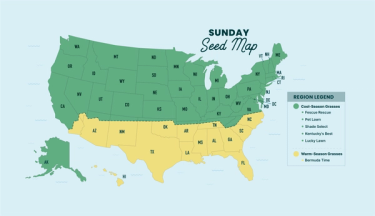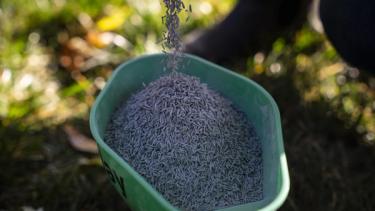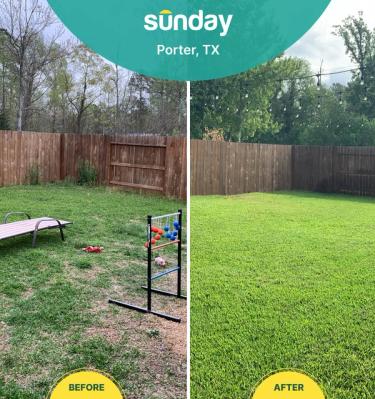Every lawn can plant grass in spring
Spring is when most of us start thinking about caring for our lawns. It’s a time for growth, getting back outside, and regaining our connection to the piece of land we care for.
Plus, it’s the perfect time to seed your lawn—no matter what type of grass you're growing—as both warm- and cool-season lawns reach the perfect seeding temperatures to seed in spring.

Benefits of spring seeding
Growth rates are high or increasing
With soil and air reaching the right temperatures, most grasses will grow deeper roots below ground and longer leaf blades above ground. When your grass starts to grow, this is a signal that grass seeds can germinate, too.
Ability to establish grass in time for summer
Summer can be tough on lawns, but establishing grass before stressful conditions can help. A dense lawn can be more resilient to summer heat and other stressful conditions than a thinning or patchy lawn.
Protect your local ecosystem
Seeding has more benefits than just aesthetics. Planting grass actually offers eco-benefits. Yes, really! Your lawn can help decrease soil runoff and filter sediment and nutrients before they enter local water systems.
When is the best time to seed
This depends on what type of grass you're growing and your location.

Northern and transitional lawns
Early spring is a good time to seed cool-season grasses, patch bare spots, and repair damage from winter diseases like snow mold. You can plant cool-season lawns when daily average temperatures are consistently between 55–75 degrees Fahrenheit.
Southern regions
You can seed warm-season lawns like Bermudagrass when daily average temperatures are between 70–90 degrees Fahrenheit. Not leaving any non-seeded lawns out—late spring is also a good time to propagate warm-season grasses, too.
Sunday Tip:
If you seed warm-season or cool-season grasses before optimal growing temperatures, it’s very likely that the seeding will not be successful.
How to seed your lawn in spring
Wondering how to plant grass seed? Here's a quick run-through.
- Pick the right grass seed.
- Mow your lawn shorter than usual and remove clippings.
- Spread seeds uniformly based on appropriate seeding rates. Find the right rates in our detailed grass seed instructions.
- Keep soil moist by lightly watering 1-2x daily until seeds germinate and reach ~2” in height.
Sunday Tip:
Stay off growing grass to ensure that grass grows to establishment. Fencing off seeded areas from kids and pets is a great way to ensure successful seeding.

Helpful tips for spring seeding
While spring seeding is a good practice for all lawns, there are things to watch out for as you grow your new seed.
- Grass takes time to grow. Each seed may require different expectations and timelines for germination, or to sprout. Here are common germination rates for most types of grass seed:
- Fescues: 6-12 days
- Perennial rye: 3-7 days
- Kentucky bluegrass: up to 21 days
- Bermudagrass: 7–21 days
- Competition from weeds. Spring means growth, which means peak timing for weeds to grow. Watering in seed at this time can also mean increased weed germination. Continue to remove weeds as you can.
- Seasonal growth differences. Spring seeding is more shoot growth and less root growth, meaning the grass may not be as strong in summer. Monitor for this and reseed if necessary.
- Summer can be tough on a lawn. However, establishing grass ahead of it can help. Thick, lush grass can withstand heat or drought stress better than a thinning or patchy lawn.
What if I miss spring seeding?
The window for spring seeding usually ends when daily average temperatures remain at 80 degrees for cool-season lawns and 95 degrees for warm-season lawns. So, what do you do if you miss this window?
Well, spring isn't the only time to seed your lawn. It's effective, but other seasons are even better for warm and cool grasses.
- For cool-season lawns, continue patching bare spots as needed and saving the rest for fall seeding, the best time to seed cool-season turf.
- If you have a warm-season lawn, you’re in luck—the prime time to seed is actually just ahead in early to mid-summer. Keep patching bare spots as needed, and save your grass seed for summer.
Trouble seeding grass this spring?
If you have bare ground without grass or weeds, there’s likely an issue in the soil that needs to be resolved. Fix these problems first, then plant grass. Here are a few ways to help your seed thrive:
- Improve lawn care basics (like mowing, watering, and fertilizing)
- Manage shade in your lawn
- Fix watering issues
- Improving soil issues like high-traffic
Resolving any of these issues can improve grass seed growth. For extra guidance, contact our team of Expert Lawn Advisors.

Let's get growing
Our lawn engine uses satellite data to map out your lawn size and determine things like average rainfall, common weeds, and pest activity.
Cited Sources
Lawn Management Through the Seasons. Penn State University Extension.
Lawn Care: The Easiest Steps to an Attractive Environmental Asset. Cornell University.



















